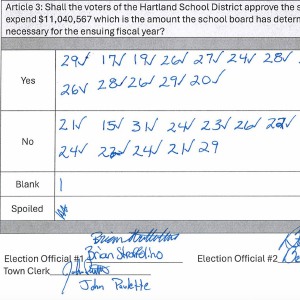Column: Dartmouth dorm plan doesn’t address housing issue
| Published: 01-14-2023 10:05 PM |
Dartmouth College officials bill their current plan to build housing for 400 undergraduate students on Lyme Road as a solution to a drastic shortage of beds on campus. There are two parts to that assumption.
One is quite accurate; Dartmouth absolutely needs more student housing. Adding a residence hall was a stated goal of their $3 billion dollar capital campaign. The campaign was a big success; except that no dorm was built. The second assumption, that the proposed dorm project would be an effective solution to their housing problem is equally deceiving. If built, the 400 beds would serve as “swing space” for the next 10-12 years while existing college dormitories are renovated. So, for the foreseeable future, neither the college nor the Upper Valley would see any easing of the housing crunch.
Dartmouth did hold some community meetings about a new dorm; any discussion of better alternatives was off the table. If Dartmouth is serious about doing something about housing, here is a three-point plan with other options that would help students and area residents.
First, five years ago Dartmouth was committed to building an undergraduate dorm next to Alumni Gymnasium. The college owns this land, and the parcel is adjacent to existing college dorms. There are no neighborhood abutters and it is in the Institutional Zone. Getting approval from the town of Hanover would be straightforward. College officials claim the site is “complicated to build on.” Guess what? That is true of virtually every large building site.
The site next to the gym keeps students on the core part of campus and preserves the college’s identity as a residential rather than commuting campus. A dorm here would provide a better, and safer, college experience for the students.
Second, the recent zoning changes for the West Wheelock District provide a great opportunity for Dartmouth. The college owns six parcels in this neighborhood that contain old and inefficient apartments. With the expanded zoning flexibility, the college can build new, larger and more attractive apartments along West Wheelock. The college already owns the land, and it is quite close to campus, an easy walk to either the Green or the West End campus buildings. It would be apartment style housing; something the college is committed to providing for students. Replacing old structures with something better is a great environmental statement; no green space is sacrificed, and students could walk where they need to go.
These first two projects could easily provide the 400 new beds the college needs for students. That is certainly very positive, but it still does not solve the Upper Valley’s larger, and equally urgent, housing needs.
The third project would be for Dartmouth to finally develop the Rivercrest site. This large property was the site of several units of college housing for faculty and staff before they were razed 20 years ago. The plan at the time was for the college to rebuild with newer and better housing. The site has gone untouched for several years. The town has identified Rivercrest as a preferred site for residential housing north of town in what is often referred to as the Lyme Road Village neighborhood. The benefits are many. This land has been used for housing and much of the infrastructure is still in place. There is already an Advance Transit stop at the entrance. There is room for a large combination of single-family homes and townhouses that would truly be a huge help to the area’s housing needs. Are there problems with the site? Of course, there always are. A small segment of the site next to CRREL has had to be remediated because of some long-ago contamination. The site is now ready for development and could be built in stages.
Article continues after...
Yesterday's Most Read Articles
 Hartland voters successfully petition for school budget revote
Hartland voters successfully petition for school budget revote
 JAG Productions announces closure, citing ‘crisis facing the arts’
JAG Productions announces closure, citing ‘crisis facing the arts’
 Hanover’s Perreard may soon capture the attention of collegiate coaches in two athletic pursuits
Hanover’s Perreard may soon capture the attention of collegiate coaches in two athletic pursuits
The three plans mentioned here are not perfect. However, they are far more useful and practical in solving Dartmouth’s, and the region’s, housing issues than their proposed dorm. The proposed dorm has been heavily opposed by Hanover residents, the Dartmouth faculty and local conservation groups. The college’s own traffic impact plan projects over 500 round trips per day to get students back and forth over the 1.5 mile commute to core campus. It is simply not a reasonable plan. Dartmouth does need more beds for undergraduates. That does not mean that all 400 beds need to be in one spot. And it does not mean that the only acceptable site is 1.5 miles away from campus. Dartmouth needs to go back to the drawing board and accept that there are far better ways to solve their legitimate housing concerns.
Dartmouth’s proposal for the dorm project will go before the Hanover Zoning board on Jan. 26. The college requires a “special exception” from the board for the project to proceed. The board can turn down the application if it determines it will do any or all of three things:
■Adversely affect the character of the neighborhood.
■Adversely affect the highways and sidewalks (and the use thereof) within the area.
■Adversely affect town services and facilities.
I would encourage anyone who believes that these criteria exist to attend the Zoning Board meeting; it is open to the public and Hanover residents can share their opinions. While this is clearly most important for Hanover residents, decisions made here will affect the character of Dartmouth College and the future of housing in the region.
Barry Harwick is a Hanover resident, a Dartmouth alum from the class of 1977 and served as a track and cross-country coach at the college from 1992 to 2020.

 Editorial: Chris Sununu’s moral vacuum
Editorial: Chris Sununu’s moral vacuum Editorial: Gambling tarnishes America’s sporting life
Editorial: Gambling tarnishes America’s sporting life By the Way: A white nationalist’s many mistruths
By the Way: A white nationalist’s many mistruths Column: The age-old question of what to read
Column: The age-old question of what to read
